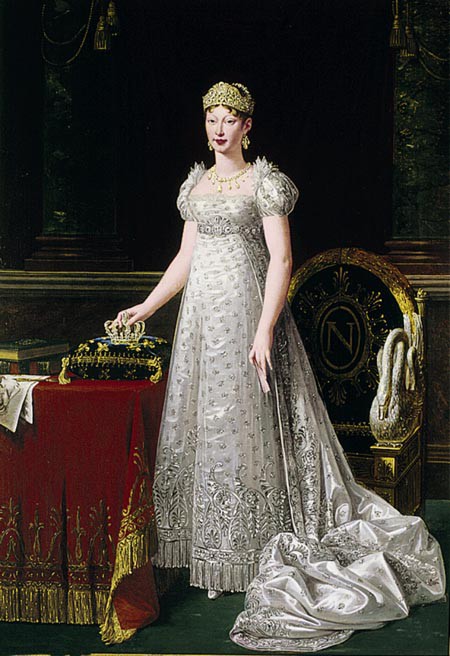This contemporary portrait of the empress Marie Louise is a perfect example of an official portrait. The canvas is still in its original frame, itself decorated with the usual bees. And Lefebvre’s painting clearly received imperial approval since two further slightly varied copies were made, one of which was bought by Chaumet in 1975 and the other (much bigger (285 x 210 cm) and later version (1814)) currently held at the Château de Versailles.
The particular importance of this work is that it preserves an important visual source for Marie Louise’s jewellery, notably the pieces given to her as part of her wedding presents. Indeed, the painting here shows her wearing some of the finest diamonds she possessed (though some actually belonged to the French crown). On her head is the diadem and comb which, together with the earrings and belt, formed part part of the famous diamond parure created by the jewellers François-Regnault Nitot in 1810 and which cost 3,779,613.92 Francs; fifty-two of the stones came from the French treasury, the rest were provided by the goldsmith. Here on the empress’ body were some of the state’s most valuable stones; in the centre of the diadem (a typically Neoclassical brorrowing from Antiquity) stand the Fleur-de-Pêcher (Peachflower) diamond, an oval gem of 25.82 carats, and the Huitième Mazarin (Eighth Mazarin); to the left and right are the Grand-Mazarin (Grand Mazarin) and the Diamant du Roi de Sardaigne (King of Sardinia’s diamond). The 1,514 stones in the diadem wieghed almost 830 carats (1 carat equals a fifth of a gramme) and were valued at 988,319.06 Francs. The comb alone had 245 diamonds provided by Nitot and was worth 147,751.24 Francs.
The ‘girandole’ earings were exceedingly popular during the First Empire, and the aim was that they should match the falling curls of hair, clearly of classical derivation. The two central pearshaped diamonds belonged to the state, the rest came from Nitot, and the ensemble of 56 stones was worth 218,606.75 Francs.
The necklace, framed by the collerette on the dress, is the one that Napoleon gave to Marie Louise on the birth of the King of Rome in 1811: and this was a decoration that she was to wear throughout her later period as Duchess of Parma. The 234 gems weighed about 263 carats and were worth 376,275 Francs. This necklace still exists (although two brilliants were later removed) and is held at the National Gem Collection at the Smithsonian Institution in Washington (USA), the generous gift in 1962 of Marjorie Merriweather Post. Though recent scientific research has confirmed that rare quality of the diamonds, it has not made it possible to trace the origin of the stones, which could be Indian from Golconda or Brazilian.
In strict accordance with First-Empire style, the train was supported by a belt which runs under the bust and not over the shoulders. Onto this belt were added stones which came from a belt that had belonged to Josephine, notably Mazarins XVII and XVIII (from the national collection). The 73 diamonds in the belt were estimated at 385,752.50 Francs; the piece was however to be dissassembled in 1812 and used to make a baudrière destined for the emperor.
As for the silk court gown worn by Marie Louise, whilst it may not be a ‘jewel’, it was made by the renowned stylist Le Roy. The pale light cast by the silver embroidery on the tulle seems to render the materials and decorations almost touchable.
Francesca Sandrini, director of the Museo Glauco Lombardi (tr. & ed. P.H. & I.D.)
May 2011
Bibliography related to the jewellery
GAILLOU Eloïse, POST Jeffrey E., “An Examination of the Napoleon Diamond Necklace”, in Gems & Gemology, vol. 43, n. 4, Winter 2007, pp. 352-357
HUREL Roselyne, SCARISBRICK Diana, Chaumet Paris deux siècles de création, catalogue of the exhibition held at the Musée Carnavalet, Paris 1998, pp. 32-33
MOREL Bernard, Les Joyaux de la Couronne de France, Belgium 1988, pp. 269-272 and 286


